“Film Stars Don’t Die in Liverpool” (2017). Cast: Annette Bening, Jamie Bell, Julie Walters, Vanessa Redgrave, Kenneth Cranham, Stephen Graham, Frances Barber, Leanne Best. Director: Paul McGuigan. Screenplay: Matt Greenhalgh. Book: Peter Turner, Film Stars Don’t Die in Liverpool. Web site. Trailer.
Falling in love is undoubtedly one of the greatest joys of life. The passion, fulfillment and bliss that come from it are indescribable and beyond compare. Unfortunately, when it goes wrong or becomes burdened by extenuating circumstances, it can have a debilitating, painful downside. Those ups and downs are the subject matter of the new, fact-based romance, “Film Stars Don’t Die in Liverpool.” Fading film star Gloria Grahame (Annette Bening) takes to the stage to prop up her sagging career in the new, fact-based romantic drama, “Film Stars Don’t Die in Liverpool.” Photo by Susie Allnutt, courtesy of Sony Pictures Classics.[/caption]
Fading film star Gloria Grahame (Annette Bening) takes to the stage to prop up her sagging career in the new, fact-based romantic drama, “Film Stars Don’t Die in Liverpool.” Photo by Susie Allnutt, courtesy of Sony Pictures Classics.[/caption]
In 1978 London, aspiring actor Peter Turner (Jamie Bell) had a passing encounter with his new neighbor, Academy Award-winning actress Gloria Grahame (Annette Bening), an aging film star who had fallen out of favor in recent years. Grahame, a vampish blonde starlet who earned a reputation for playing “bad girls,” made a name for herself as the flirtatious Violet Bick in Frank Capra’s “It’s a Wonderful Life” (1946) and won an Oscar for her performance in “The Bad and the Beautiful” (1952). However, over time, with age, fading looks and the rising popularity of screen competitors like Marilyn Monroe, Gloria’s star gradually declined. She also developed a reputation for being somewhat difficult to work with, all of which caused her to be relegated to more obscure roles. She took whatever parts she could get on stage, screen and TV, both in Europe and America.
Off-screen, Gloria’s persona in many ways echoed her movie presence, and, when she met Peter, she turned on the charm with him in much the same way her characters did with their romantic prospects. Despite their vast difference in age – she was 54, he was 28 – there was an undeniable chemistry between them, a bond that quickly birthed a torrid relationship. But, as became apparent over time, the romance was driven by more than just hormones; Gloria and Peter truly were in love. Despite an age difference of 20+ years, onetime screen idol Gloria Grahame (Annette Bening, left) and aspiring actor Peter Turner (Jamie Bell, right) find love in “Film Stars Don’t Die in Liverpool.” Photo by Susie Allnutt, courtesy of Sony Pictures Classics.[/caption]
Despite an age difference of 20+ years, onetime screen idol Gloria Grahame (Annette Bening, left) and aspiring actor Peter Turner (Jamie Bell, right) find love in “Film Stars Don’t Die in Liverpool.” Photo by Susie Allnutt, courtesy of Sony Pictures Classics.[/caption]
However, as much as Peter adored Gloria (and vice versa), the couple also had its problems. Gloria’s increasing obsession with her looks, her denial about her advancing age and her efforts at keeping a lid on secrets from her past all caused her to be capricious and temperamental. She also held on to her share of unrealistic expectations, such as a hope that she would one day be cast to play the role of Juliet in Shakespeare’s famous romantic tragedy, a disappointment waiting to happen that would assuredly lead to tantrums, pouting and despair. Peter often attempted to comfort his beloved in these situations, but he often became the unwitting target of her wrath, frustration and sarcasm. And, as new and even bigger challenges began affecting Gloria, the strain between them grew progressively worse. But, despite indications to the contrary, when the real reasons behind Gloria’s behavior became apparent, it was obvious that she loved Peter more than he or anyone knew, a fact that was buried under some odd covering and something that remained hidden until circumstances became dire.
It’s unfortunate that the depth of our feelings often isn’t revealed until we find ourselves in crisis, as was the case with Peter and Gloria. Of course, it’s not realistic to expect that to change as long as we’re mired in denial about our circumstances. Having the courage to face the truth about ourselves and our emotions can help us break through such obstacles, making it possible for us to find out what it means to truly be in love – and to express it freely to those we care about.
Such circumstances and attitudes are a direct outgrowth of our thoughts, beliefs and intents, the building blocks of the conscious creation process, the means by which we each manifest the reality we experience. And that existence will invariably faithfully reflect the nature of those thoughts, beliefs and intents, for better or worse, whether we like it or not. Aspiring actor Peter Turner (Jamie Bell) falls hard for a faded screen idol in the new romantic drama, “Film Stars Don’t Die in Liverpool.” Photo by Susie Allnutt, courtesy of Sony Pictures Classics.[/caption]
Aspiring actor Peter Turner (Jamie Bell) falls hard for a faded screen idol in the new romantic drama, “Film Stars Don’t Die in Liverpool.” Photo by Susie Allnutt, courtesy of Sony Pictures Classics.[/caption]
It’s hard to say if Gloria was aware of any of this, but, as the film illustrates, her reality indeed mirrored the beliefs she held. Try as she might to squelch things about herself, her life and her past, those influences lingered in the makeup of her existence, ever looming and threatening to emerge when they could no longer remain hidden under the weight of containment. But, rather than own up to them and acknowledge their presence, Gloria would generally struggle to hide or minimize them, even from those who cared about her, like her adoring Peter and his kindly parents (Julie Walters, Kenneth Cranham), who freely treated her like one of the family. Instead of accepting the help and compassion they showed her; Gloria sometimes pushed them away in apparent acts of ingratitude.
But were Gloria’s actions truly thankless? Superficially speaking, that would seem to be the case. Upon further scrutiny, however, there was more to her behavior than met the eye. Those who looked closely enough might be able to see what her real motivations were. But, to do that, onlookers would need to make use of their powers of discernment to be able to see what was truly going on. This would require them to strip away the camouflage that obscured their perceptions and perspectives, a practice that, for example, called upon them to distinguish the person from the characters she was known for playing – something that might not have been easy to do but that would reveal significant distinctions, despite the superficially similar trappings that characterized the two. Those who succeeded at this would undoubtedly see a very different picture, one depicting the real Gloria, someone who was not her screen presence, even if it often seemed that way.
Making distinctions like this is a lesson we could all learn from. Failure to do so often results in misunderstandings, frequently with painful or frustrating consequences. Were we to do that, we could spare ourselves considerable hardship, enabling us to get the most out of our relationships and circumstances, unburdened by the anxiety and heartache that come from misinterpretations, a crucial consideration when we’re faced with situations in which we may not have much time to act. Caring, compassionate Bella Turner (Julie Walters) treats a celebrity guest in her home like one of the family in the touching, new, fact-based romance, “Film Stars Don’t Die in Liverpool.” Photo by Susie Allnutt, courtesy of Sony Pictures Classics.[/caption]
Caring, compassionate Bella Turner (Julie Walters) treats a celebrity guest in her home like one of the family in the touching, new, fact-based romance, “Film Stars Don’t Die in Liverpool.” Photo by Susie Allnutt, courtesy of Sony Pictures Classics.[/caption]
This vastly underrated cinematic gem definitely deserves wider attention – and far more recognition – than it has received. With what is arguably Bening’s best screen performance, coupled with a fine counterpart lead portrayal by Bell, this heartfelt romantic tearjerker justifiably earns every bit of emotion it evokes from audiences. It also features one of the best original songs to grace the screen in ages, Elvis Costello’s fittingly moving You Shouldn’t Look at Me That Way. If you enjoy good old-fashioned love stories, go see this one, despite what the cynics might say (but keep the tissues handy).
“Film Stars Don’t Die in Liverpool,” unfortunately, has not received the awards season recognition it deserves. Thankfully, though, the BAFTA Awards – the British equivalent of the Oscars – came through to help make up for this, honoring the picture with nominations for best actor, (Bening), actress (Bell) and adapted screenplay. It would have been gratifying to see this offering pick up additional accolades, but at least these three nods are better than nothing (which really would have been a shame).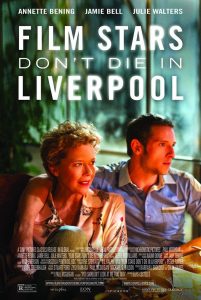
Our time on this planet is shorter than most of us tend to realize, and it would be in our best interests to make the most of it while we have the chance, especially where love is concerned. Gloria and Peter bring that truth front and center, shining a brilliant light on it to help us appreciate its veracity and significance. Let’s hope we’re paying attention.
Copyright © 2018, by Brent Marchant. All rights reserved.
Wednesday, January 31, 2018
‘Film Stars’ probes the depth and truth of love
Tuesday, January 30, 2018
‘Molly’s Game’ wrestles with what drives our motivations
“Molly’s Game” (2017). Cast: Jessica Chastain, Idris Elba, Kevin Costner, Michael Cera, Jeremy Strong, Chris O’Dowd, J.C. MacKenzie, Brian d’Arcy James, Bill Camp, Graham Greene, Claire Rankin, Samantha Isler, Piper Howell. Director: Aaron Sorkin. Screenplay: Aaron Sorkin. Book: Molly Bloom, Molly’s Game: From Hollywood's Elite to Wall Street's Billionaire Boys Club, My High-Stakes Adventure in the World of Underground Poker. Web site. Trailer.
The motivations that drive our actions are usually clear, but sometimes they may stubbornly elude us, so much so that, after a while, we might not wonder (or even care) what they are. This often happens when we get caught up in circumstances in which we lose sight of how we got there and don’t know how to extricate ourselves. And, by then, we may find ourselves on a treadmill from which there is no apparent escape. So it was for an Olympic hopeful whose career came to an abrupt end, forcing her to change directions and embark on a journey she never expected, as detailed in the new, fact-based drama, “Molly’s Game.”
After years of intensive training as a freestyle skier, Olympic hopeful Molly Bloom (Jessica Chastain) sought to secure a spot on the U.S. squad for the 2002 Winter Games in Salt Lake City. Through the years, Molly’s demanding father, Larry (Kevin Costner), pushed her hard to become a champion, first as a child (Piper Howell) and later as a teen (Samantha Isler). In some ways, Molly resented the relentlessly rigorous training, but it also imbued her with an undeniable drive for success, one that helped her defy the odds and overcome a near career-ending injury in her teens. And, by the time she made her Olympic bid, she seemed poised for a date with destiny – save for a traumatic fall during competition that knocked her out of the running and off of the slopes for good.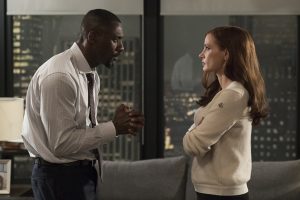 Onetime Olympic hopeful-turned-poker game operator Molly Bloom (Jessica Chastain, right) consults her high-powered lawyer, Charlie Jaffey (Idris Elba, left), when she finds herself in hot water in writer-director Aaron Sorkin’s latest offering, “Molly’s Game.” Photo by Michael Gibson, Motion Picture Artwork, courtesy © STX Financing, LLC.[/caption]
Onetime Olympic hopeful-turned-poker game operator Molly Bloom (Jessica Chastain, right) consults her high-powered lawyer, Charlie Jaffey (Idris Elba, left), when she finds herself in hot water in writer-director Aaron Sorkin’s latest offering, “Molly’s Game.” Photo by Michael Gibson, Motion Picture Artwork, courtesy © STX Financing, LLC.[/caption]
Fortunately for Molly, she had a backup plan … sort of. As a bright, educated college graduate, she possessed the intellect to become a success in virtually any field she chose. Unfortunately, she lacked direction and wasn’t sure what she wanted to do. She contemplated attending law school but instead chose to move to Los Angeles for a year to find her focus, a decision that infuriated her father. Nevertheless, Molly headed to California in search of whatever life had in store for her.
Molly initially took a job as a waitress in an upscale Los Angeles nightclub, one frequented by big-tipping celebrities and high rollers. While working there, she met Dean Keith (Jeremy Strong), an obnoxious but extravagant real estate developer who offered her a position as his office manager. In no time, Molly became a key player in Dean’s organization, including as operator of his high-stakes underground poker game, a contest that regularly attracted professional athletes, investment bankers and movie stars, most notably the infamous Player X (Michael Cera), a well-known but unidentified Hollywood actor. Although Molly knew virtually nothing about the game at the outset, she learned quickly, hauling in huge tips from the players for her efforts as the event’s attentive hostess. She became so successful, in fact, that Dean felt threatened by her, eventually firing her. But, with the contacts she made through Dean’s game, Molly was soon able to set up an operation of her own, one that was set in a more lavish setting – and with even bigger stakes.
Over time, Molly’s success blossomed as the ranks of her game’s high rollers swelled. But, given the unsavory nature of some of the players, she soon fell prey to the questionable activities of some of her regulars. Almost overnight, her astounding success evaporated, prompting her to relocate her operation from Los Angeles to New York, a move designed to cash in on the potential fortune to be made from the city’s wealthy voracious gamblers. Before long, however, Molly found herself in the company of a cabal of even shadier characters, including members of the Russian mafia and Italian mobsters seeking to horn in on her operation. What’s more, to keep going under the mounting pressure, Molly propped herself up with an array of pharmaceuticals, a move that increasingly eroded her perspective. Clearly it was time to get out. But how?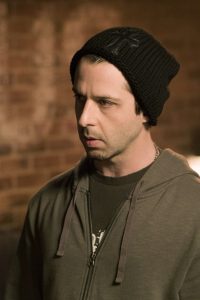 Real estate developer Dean Keith (Jeremy Strong) has an interesting proposition for one of his employees in the new, high-stakes drama, “Molly’s Game.” Photo by Michael Gibson, Motion Picture Artwork, courtesy © STX Financing, LLC.[/caption]
Real estate developer Dean Keith (Jeremy Strong) has an interesting proposition for one of his employees in the new, high-stakes drama, “Molly’s Game.” Photo by Michael Gibson, Motion Picture Artwork, courtesy © STX Financing, LLC.[/caption]
The answer came in the form of an FBI raid. With all of her assets seized, Molly moved home with her mother (Claire Rankin) and wrote a book about her experiences. Under the impression that the worst was behind her, Molly sought to move on with her life – that is, until she was arrested again, charged with running illegal gaming activities, specifically the operations that were shut down two years previously during the initial FBI raid. And so, faced with severe penalties and long jail time, she hired a high-powered lawyer, Charlie Jaffey (Idris Elba), to help her get out for good as unscathed as possible.
To find her way clear, however, Molly needed to get serious about how she ended up in this situation. That meant more than figuring out how she came to know such colorful characters as card sharp Harlan Eustice (Bill Camp), Ponzi scheme operator Bad Brad (Brian d’Arcy James) and Russian mob go-between Douglas Downey (Chris O’Dowd); it meant facing up to the reasons – the real reasons – why she pursued this course in the first place. And that meant getting in touch with those ever-elusive motivations. She needed to address what it meant to be the Molly she had become – and why – perhaps for the first time ever.
In circumstances like this, it’s far too easy to just shrug our shoulders and say “Things just happen.” But such attitudes are all too convenient and the height of irresponsibility. There are reasons behind our behavior, and getting to the bottom of them is key to understanding them, especially if we’re wrapped up in questionable activities that we hope to get past and never repeat again.
This is where the importance of our awareness of the conscious creation process comes into play, for it sheds light on how and why our reality emerges as it does through the power of our thoughts, beliefs and intents. It helps us to understand our motivations and how they lead to the existence we experience, for better or worse. That’s the challenge put to Molly as she works her way through her personal odyssey. High-rolling gambler Player X (Michael Cera) quickly becomes a regular in a high-stakes poker game operated by a onetime Olympic hopeful in the new, fact-based drama, “Molly’s Game.” Photo by Michael Gibson, Motion Picture Artwork, courtesy © STX Financing, LLC.[/caption]
High-rolling gambler Player X (Michael Cera) quickly becomes a regular in a high-stakes poker game operated by a onetime Olympic hopeful in the new, fact-based drama, “Molly’s Game.” Photo by Michael Gibson, Motion Picture Artwork, courtesy © STX Financing, LLC.[/caption]
 Card sharp Harlan Eustice (Bill Camp) savors the thrill of the game when it comes to high-stakes poker in “Molly’s Game.” Photo by Michael Gibson, Motion Picture Artwork, courtesy © STX Financing, LLC.[/caption]
Card sharp Harlan Eustice (Bill Camp) savors the thrill of the game when it comes to high-stakes poker in “Molly’s Game.” Photo by Michael Gibson, Motion Picture Artwork, courtesy © STX Financing, LLC.[/caption]
As Molly’s story unfolds, it’s apparent that her motivations have little to do with running a gambling operation per se. But, if so, then what is the driving force behind her actions? That’s what she needs to discover. Yet, the more she becomes embroiled in her circumstances, the more she loses sight of where she is, how she got there and why. If she ever hopes to escape her situation, she needs to get serious about addressing such matters – and fast.
If Molly’s to uncover the reasons behind her actions, she needs to ask herself questions like what does she get out of these activities? What accomplishments can she lay claim to from them? Does the operation, its attributes or its participants provide clues as to why she’s involved in it? And, perhaps most importantly, how does running a game with such dangerous and seedy elements satisfy her needs?
As the film’s narrative plays out, clues answering these questions begin to emerge. However, ironically enough, the individual least able to recognize them is Molly herself. In part this is undoubtedly due to being so caught up in the day-to-day matters of the game that she can’t see her way clear; the proverbial forest for the trees metaphor comes to mind. But it’s also partly attributable to avoiding the aforementioned questions in the first place, be it unwittingly or intentionally. In Molly’s case, one could argue that she seems to be blissfully ignorant of her underlying motivations (and willingly so), either because they involve something in which she has no pressing interest or, more likely, because they relate to issues she’s unwilling or not ready to face. Addressing the pain of the past is a key concern for onetime Olympic hopeful-turned-poker game operator Molly Bloom (Jessica Chastain, right) when confronting her demanding father, Larry (Kevin Costner, left), in writer-director Aaron Sorkin’s “Molly’s Game.” Photo by Motion Picture Artwork, courtesy © STX Financing, LLC.[/caption]
Addressing the pain of the past is a key concern for onetime Olympic hopeful-turned-poker game operator Molly Bloom (Jessica Chastain, right) when confronting her demanding father, Larry (Kevin Costner, left), in writer-director Aaron Sorkin’s “Molly’s Game.” Photo by Motion Picture Artwork, courtesy © STX Financing, LLC.[/caption]
In a situation like this, we’re nearly always forced into facing beliefs we don’t want to address, be it because we find them painful, embarrassing or otherwise uncomfortable. Yet, if we ever hope to get past them – both to rewrite them more to our liking and to generate a more amenable outcome – we must first confront them in their present form. As the heat gradually gets turned up on Molly, the means to make this happen start to arise. Like many of us, she may not enjoy having her hand called, but, if that’s what it takes, then that’s what must transpire if things are ever going to change.
If Molly is going to unravel her motivations, she needs to examine the beliefs that spawned them, particularly how those beliefs came into being. This means analyzing the intellectual and intuitional input that led to their formation. Taking that into consideration, Molly has the intellectual aspect covered; as a bright, scholarly sort, she’s perceptive, quick-witted and incisively attuned, as evidenced by how fast she learns the ropes of manifesting a successful high-stakes gambling operation, all the way down to the finest of nuances. However, intuitionally speaking, she needs to take off her blinders or, at the very least, sharpen her focus to pay attention to those significant, if seemingly irrational elements that play a role just as important as her intellect in belief formation and reality creation. If she were to do that, she’ll get her answers – and probably a lot quicker than she thinks possible.
On a cursory glance, one might be tempted to think that Molly’s inability or reluctance to identify her motivations has to do with the somewhat shady nature of her vocation, that she might not want to face the truth given the character of her work and her associates. But, counterintuitive though it might be, Molly actually has a strong ethical streak that runs through her, one driven by an apparent sense of integrity. She does her level-best to run an honest game, despite the questionable nature of the operation itself and the dubious nature of her colleagues. She also works hard to preserve the privacy of her clients, refusing to divulge names when offered plea deals and even protecting the identity of the aforementioned Player X. Russian mob go-between Douglas Downey (Chris O’Dowd, right) connects high-stakes poker game operator Molly Bloom (Jessica Chastain, left) with questionable new players in the new fact-based drama, “Molly’s Game.” Photo by Michael Gibson, Motion Picture Artwork, courtesy © STX Financing, LLC.[/caption]
Russian mob go-between Douglas Downey (Chris O’Dowd, right) connects high-stakes poker game operator Molly Bloom (Jessica Chastain, left) with questionable new players in the new fact-based drama, “Molly’s Game.” Photo by Michael Gibson, Motion Picture Artwork, courtesy © STX Financing, LLC.[/caption]
Given the foregoing, then, Molly wouldn’t appear to have issues with qualities like honesty and integrity, something that she should apply to her treatment of herself as much as she does to that of others. So, once again, the gaming mistress is faced with the question of her apparent inability to assess her motivations for setting up and running her operation. It repeatedly raises the question, why won’t she do so?
When the truth behind those motivations is at last revealed, we may be shocked at what we see. In fact, her reasons would appear to have no discernible relation to their associated manifestations. Nevertheless, as the connection becomes clarified, it’s possible to see how and why her existence has materialized as it has, something we should bear in mind when it comes to understanding the nature of our own realities, no matter how seemingly incongruous the nexus between the motivations and manifestations may appear. It’s with this knowledge that we can then begin to reformulate our beliefs to create an existence more in line with our hopes, goals and desires. And so it is with Molly, too.
Given Molly’s obliviousness to her own motivations suggests that she likely has little awareness of the metaphysical process with which they’re associated. However, after going through a scenario like this, it’s a pretty safe bet that she’ll make more of an effort to keep it in mind going forward. It’s hard to ignore the lesson that comes from an experience as significant (and challenging) as this, and any of us who go through something comparable to this and attempt to downplay its impact do so at our own peril. Consider this a cautionary tale well worth taking to heart.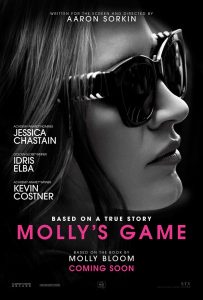
While much of “Molly’s Game” plays like a crime drama, the underlying issue, as discussed above, is finding oneself. This offering from writer and first-time director Aaron Sorkin spins an intriguing yarn about a one-of-a-kind character, and it does so by successfully maintaining a brisk pace for its 2:20 runtime. The film also serves up yet another sparkling performance by Chastain, who once again demonstrates her tremendous skill at being able to disappear into a role, delivering one of the best lead performances of 2017, an effort that earned her Golden Globe and Critics Choice Award nominations for best actress. Backing Chastain is a superb ensemble, especially Elba, Costner, Cera and Camp, all of whom deliver some of their best on-screen work. Though I would have preferred that the dialogue sounded a little more natural and a little less “written,” the picture nevertheless features a capably crafted script adaptation, one that pulled down Golden Globe, Critics Choice, BAFTA and Oscar nominations for best screenplay.
Stripping away the veneer to find out who we really are and what we’re really trying to accomplish may prove to be quite a taxing process. But, if we’re ever to get the answers we seek in these areas, sometimes we have to pause to assess our circumstances, taking time to stop, catch our breath, and give our thoughts, beliefs and intents a good, hard look. We might be surprised at what we see. We may not like it, either. But at least such evaluations are honest, and that’s as good a starting point as any to determine where we are – and where we want to go.
Copyright © 2018, by Brent Marchant. All rights reserved.
Monday, January 29, 2018
‘The Post’ examines what it takes to do the right thing
“The Post” (2017). Cast: Meryl Streep, Tom Hanks, Sarah Paulson, Bob Odenkirk, Tracy Letts, Bradley Whitford, Bruce Greenwood, Matthew Rhys, Alison Brie, Carrie Coon, Jesse Plemons, Michael Stuhlbarg, Justin Swain, Curzon Dobell. Director: Steven Spielberg. Screenplay: Liz Hannah and Josh Singer. Web site. Trailer.
When faced with hard choices, we may not know which way to turn. That’s especially true when all of our options appear problematic. Deciding which of the seemingly troublesome outcomes will prove least onerous can try our patience and test our resolve. At the same time, though, such scenarios can sharpen our scrutiny skills, especially when it comes to drawing upon our intuition and integrity to arrive at an amenable solution. So it was for a group of media professionals who found themselves with their backs up against the wall as seen in the new fact-based journalism drama, “The Post.”
In 1971, The Washington Post was going through a bumpy transition period. The family-owned newspaper, managed by publisher Kay Graham (Meryl Streep), was in the process of going public to improve its financial position. But, to help make the publication a more attractive investment option, the paper also needed to look at upping its editorial profile, one more in line with the first-class reporting reputation it was seeking to cultivate, a responsibility assumed by editor Ben Bradlee (Tom Hanks). This was vital in light of the changing journalism marketplace, with more major newspapers, like The New York Times, taking on more of a national – and not just a local – presence. If the Post didn’t act, it could be left in the dust by other publications, threatening the company’s future.
The opportunity to advance the paper’s coverage came with the release of the Pentagon Papers, a 7,000-page collection of covert documents detailing the U.S. role in Vietnam – not just during the war but in the two decades preceding it, going as far back as the Truman administration. Through this disclosure by military analyst Daniel Ellsberg (Matthew Rhys), it became apparent that American interference in Vietnamese affairs was pervasive, with extensive involvement in the Asian nation’s politics, economics and society. The damning disclosure also documented the futility underlying the U.S. war effort, a campaign that continued despite insider knowledge of this inherent problem and increasingly vocal domestic disapproval of the conflict. Washington Post publisher Kay Graham (Meryl Streep, right) and editor Ben Bradlee (Tom Hanks, left) discuss the paper’s precarious future in director Steven Spielberg’s latest, “The Post.” Photo by Nick Tavernise, courtesy © Twentieth Century Fox Film Corporation and Storyteller Distribution Co. LLC.[/caption]
Washington Post publisher Kay Graham (Meryl Streep, right) and editor Ben Bradlee (Tom Hanks, left) discuss the paper’s precarious future in director Steven Spielberg’s latest, “The Post.” Photo by Nick Tavernise, courtesy © Twentieth Century Fox Film Corporation and Storyteller Distribution Co. LLC.[/caption]
The story was initially broken by New York Times reporter Neil Sheehan (Justin Swain). However, given the bombshell nature of these revelations, the Nixon administration quickly came down hard on the Times, imposing an injunction against it from publishing any further material from the secret report, given that it was allegedly leaked in violation of the federal Espionage Act. With the Times’s hands tied, this opened the door for the Post, especially when Ellsberg was identified as the source of the leak: As a former colleague of Post assistant managing editor Ben Bagdikian (Bob Odenkirk), Ellsberg found a new outlet for making additional disclosures.
Needless to say, given the magnitude of the story, Bradlee and Bagdikian jumped at the chance to pick up the gauntlet and continue publishing articles about the Pentagon Papers. However, considering that the Post’s source was the same as that of the Times, the paper soon found itself in the same position as its New York counterpart: If it published, it would be in violation of the same injunction that was now hampering the Times’s efforts.
This presented an enormous ethical dilemma for Graham. As someone who found herself in a position in which she never expected to be – she took over management of the Post after the unexpected death of her husband – and given the financial pressures on the business, she had to make the hard decision of whether or not to publish. If she allowed the Post to pick up where the Times left off, she ran the risk of prosecution and attendant penalties (including incarceration), not to mention the financial collapse of the paper that would almost assuredly follow. At the same time, if she green-lighted her staff’s plans, she would help raise the Post’s editorial reputation, a move that would also likely cast her in the light of a confirmed First Amendment champion (especially if courts ruled in the paper’s favor). Graham thus faced quite a high-stakes decision. Ben Bradlee (Tom Hanks) faces tough editorial decisions for his publication, The Washington Post, in “The Post.” Photo by Nick Tavernise, courtesy © Twentieth Century Fox Film Corporation and Storyteller Distribution Co. LLC.[/caption]
Ben Bradlee (Tom Hanks) faces tough editorial decisions for his publication, The Washington Post, in “The Post.” Photo by Nick Tavernise, courtesy © Twentieth Century Fox Film Corporation and Storyteller Distribution Co. LLC.[/caption]
For Graham, personal considerations were also on the line. As a longtime friend and confidante of former Secretary of Defense Robert McNamara (Bruce Greenwood), Graham had to weigh this relationship with the publishing dilemma she now faced. Having personally authorized the ramp-up of the Vietnam War during his tenure in the Kennedy and Johnson administrations, McNamara figured largely in the Pentagon Papers disclosures, revelations that painted him in a very different light from the person Graham thought she knew. Printing exposés about McNamara’s involvement would undoubtedly strain the bond between the two friends. But, as the former Secretary strongly cautioned, publishing further excerpts from the clandestine documents would bring the full weight of U.S. government down on the Post – and Graham.
With these circumstances in place, the stage was thus set for a high-profile showdown, one that would find its way to the U.S. Supreme Court. But, as significant as the stakes were for the paper, its owner and its staff, there was much more in jeopardy, especially where freedom of the press considerations and personal relationships were concerned. The events at the heart of this very public and personal drama thus effectively demonstrate what it means to take a stand, to do the right thing, even in the face of seemingly long odds and potentially devastating consequences. They provide the makings of a powerful, inspiring message to those staring down demanding and far-reaching challenges, circumstances where the stakes are a lot bigger than those of the principal individuals and organizations involved.
Wherever we end up, though, depends on what we seek to manifest, a product of our thoughts, beliefs and intents, the building blocks of the conscious creation process, the means by which we bring our reality into being. And what emerges through those thoughts, beliefs and intents depends on the input provided by our intellect and intuition, the forces that shape those cornerstones that lay the foundation for our existence. Learning how to tap both of those sources is thus crucial to arriving at the outcomes we look to achieve.
But what happens when we’re unsure how to proceed under certain circumstances? How can we determine what to do? It’s at those times that we need to draw upon all of our metaphysical resources as much as possible.
When it comes to accessing our intellect, most of us know how to proceed. But, as for our intuition, we’re often at a loss; we tend to be less experienced in drawing upon it, because we generally don’t trust it, seeing it as illogical or irrational, flying in the face of our intellect. Nevertheless, its input is just as significant, even if it superficially doesn’t always seem to make sense. Washington Post publisher Kay Graham (Meryl Streep) faces ethical dilemmas, both personally and professionally, in the new, fact-based journalism drama, “The Post.” Photo by Nick Tavernise, courtesy © Twentieth Century Fox Film Corporation and Storyteller Distribution Co. LLC.[/caption]
Washington Post publisher Kay Graham (Meryl Streep) faces ethical dilemmas, both personally and professionally, in the new, fact-based journalism drama, “The Post.” Photo by Nick Tavernise, courtesy © Twentieth Century Fox Film Corporation and Storyteller Distribution Co. LLC.[/caption]
When the Post was facing its publish/don’t publish dilemma, for example, Graham and Bradlee had to weigh the impact of their intellect and intuition. From an intellect standpoint, they were cautioned not proceed, that the likely consequences would be devastating. This message was reflected back in various ways, such as the threats coming from the Nixon administration, the injunction already enacted against the Times and the advice offered up by various advisors to the paper (Tracy Letts, Bradley Whitford, Jesse Plemons). At the same time, though, their intuition was urging them to move forward, to get the word out about the Pentagon Papers, because it would expose the decades-old exploits of the U.S. government, the truth about the country’s war efforts and the administration’s campaign to muzzle the press, considerations of greater importance than anything that might affect the paper and its principals. No matter how much they may have tried to downplay these concerns, they would continually reappear, nagging at them not to ignore the associated message.
This was arguably less of a concern for Bradlee than it was for Graham, given that telling the truth and getting the word out to the public were his primary job responsibilities as editor. It certainly helped that he had influences to remind him of this, such as Bagdikian’s presence, whose zealous encouragement to publish helped bolster his confidence in a decision to proceed. Graham, however, had other considerations to balance, such as the Post’s financial position; after all, concern about getting the word out would become a moot point if the paper were to go out of existence. At the same time, though, where would we be as a nation if we didn’t have a free press to tell the people the truth about what their government was doing, no matter how unsavory that truth might be? It was on that point that Graham found her way, especially as her intuition kept driving that message home, one that formed the basis of the beliefs she employed in bringing her reality into being – especially proceeding with publishing.
It’s hard to know if Graham and Bradlee consciously employed such metaphysical deliberation in their thought processes. But, when one examines how events played out, it’s easy to see that they made use of it, even if they weren’t aware of intentionally doing so. We can all be thankful for that, for it involved taking quite a risk – a leap of faith based on intuitional impulses that many of us might not be comfortable in relying upon for a decision as important as this. But, when it comes to doing the right thing, with so much riding on the outcome, we must make a concerted effort to bring about the desired result. Fortunately, we have the example set by Kay Graham and Ben Bradlee to help show us the way, and we shouldn’t be afraid to draw upon it when the need and circumstances arise. Informal meetings between Washington Post publisher Kay Graham (Meryl Streep, right) and editor Ben Bradlee (Tom Hanks, left) often turn into profound discussions about the paper’s future in “The Post.” Photo by Nick Tavernise, courtesy © Twentieth Century Fox Film Corporation and Storyteller Distribution Co. LLC.[/caption]
Informal meetings between Washington Post publisher Kay Graham (Meryl Streep, right) and editor Ben Bradlee (Tom Hanks, left) often turn into profound discussions about the paper’s future in “The Post.” Photo by Nick Tavernise, courtesy © Twentieth Century Fox Film Corporation and Storyteller Distribution Co. LLC.[/caption]
Even by drawing upon all of our metaphysical wherewithal, as this scenario demonstrates, hard choices can still be extremely difficult to deal with, no matter how obvious the right decisions might appear to outside parties. But there are tools we can draw upon to help make matters go a little more easily. Drawing upon our sense of integrity, for instance, can prove invaluable. Since it requires us to get in touch with our truest, most authentic selves, that means we must tap into our most significant core beliefs, those that rest firmly on a bedrock formed from the input of our intellect and intuition. By doing so, we greatly increase the likelihood that we’re making wise choices, even if the face of the most difficult decisions.
Likewise, as noted above, there’s the matter of faith, not the kind typically associated with a religious context but in a personal, confidence-in-oneself sense. Trusting our decisions based on the foregoing process of analysis should provide us with a high degree of comfort as to how we’re proceeding. Putting stock in this notion can help us rest assured that we’re moving ahead as we’re supposed to.
Lastly, there’s the notion of value fulfillment, the conscious creation concept related to being our best, truest selves for the benefit of ourselves and those around us. If we bear this idea in mind as we go through the deliberation process, we can, again, feel confident that we’re progressing correctly. Of course, value fulfillment itself draws heavily upon the power of integrity and faith, so it stands to reason that its significance in effective conscious creation efforts should be plainly apparent, and its impact can be seen most readily when those hard choices land on our doorsteps.
After a somewhat slow, sometimes-belabored start in which the paper’s financial woes are detailed almost to excess, “The Post” thankfully finds its legs about 40 minutes in, at last taking off on a more engaging pace as it moves toward its uplifting (albeit predictably feel good) conclusion. It’s a film with a timely (though, one can’t help but cynically wonder, regrettably tardy) message about the state of journalism in an America presently besieged by corporate media consolidation and heavy-handed attempts to quash free speech. Streep and Hanks turn in adequate performances in their lead roles (though definitely far from their best), with the real stars shining in the supporting parts (particularly Odenkirk, Greenwood and Rhys). Given the current political climate, director Steven Spielberg’s latest is the right film with the right message that liberal Hollywood adores and loves to lavish with honors. It’s just too bad that it’s not a picture that fully lives up to that aspiration.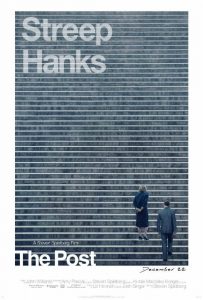
Despite its shortcomings, however, “The Post” has been extensively honored in this year’s award competitions, most recently with two Oscar nominations for best picture and actress (Streep). The film also captured three National Board of Review awards for best picture, actress (Streep) and actor (Hanks) and was named American Film Institute Movie of the Year. In addition, the picture earned six Golden Globe nominations (best dramatic picture, director, screenplay, score, dramatic actor, dramatic actress) and eight Critics Choice Award nods (best picture, director, original screenplay, score, editing, acting ensemble, actor, actress), though it took home no statues in either of these competitions.
Taking a stand is truly a noble act – but one that’s often fraught with great risk (and rewards). When up against such circumstances, we must weigh what’s at stake and the consequences of what each outcome might bring. Should we emerge victorious, however, we can look back and see just how meaningful our efforts prove to be.
Copyright © 2018, by Brent Marchant. All rights reserved.
Wednesday, January 24, 2018
This Week in Movies with Meaning
Reviews of "The Post," "Molly's Game" and "Film Stars Don't Die in Liverpool" are all in the latest Movies with Meaning post on the web site of The Good Media Network, available by clicking here.



Tuesday, January 23, 2018
Tune in for The Cinema Scribe

Tune in for the Bring Me 2 Life Podcast!
Join host Selo Closson and yours truly for a special episode of the Bring Me 2 Life radio podcast, premiering today, January 23, by clicking here. We'll discuss my new book, Third Real: Conscious Creation Goes Back to the Movies, as well as how films (including current releases) reflect conscious creation/law of attraction principles. And tune in starting January 30 for the official launch of Season 5 of the Bring Me 2 Life podcast!

Tuesday, January 16, 2018
This Week on The Cinema Scribe

This Week in Movies with Meaning
A Review of "I, Tonya," a video preview, and a look at 2017's best and worst movies are all in the latest Movies with Meaning post on the web site of The Good Media Network, available by clicking here.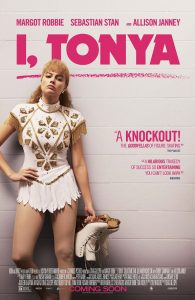


Sunday, January 14, 2018
The Best and Worst of 2017
Another year in filmdom has come and gone, and countless movie reviewers have issued their best and worst lists for 2017. And so, with that said, it’s time to add my voice to the chorus, with my choices for the cream of the crop and the curdled cream best discarded.
In the interest of full disclosure, I must confess that I did not screen every film that was released in 2017, most notably those that were distributed through limited or select channels, such as the Netflix exclusive “Mudbound.” However, I did spend considerable time staring at those flickering lights on the big screen last year, enough to make me feel comfortable in offering up my selections for the pictures that I believe represented the best and worst of past 12 months.
As always, I’d love to hear your feedback in the comments section (be civil, please). And with that, here goes:
THE TOP 10
10. “Get Out”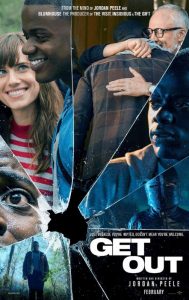
Despite some occasional pacing issues during the first hour, this satirical sci-fi thriller – often described as “Guess Who's Coming to Dinner?” meets “The Stepford Wives” – delivers hefty laughs, ample suspense and biting social commentary that might make even the most self-avowed open-minded viewers squirm. Writer-director Jordan Peele hits a home run in his debut feature, making a mark that one can only hope is a sign of things to come. Those who enjoy thought-provoking cinema with unexpected plot twists are sure to like just about everything this release has to offer.
9. “Logan Noir”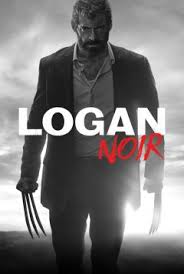
What a difference cinematography can make! This is the version of “Logan” that should have been released in the first place. As good as the full-color edition is, the noir version’s stunning black-and-white cinematography takes an entertaining bubble gum action-adventure and effectively elevates it to the level of a serious screen drama. The atmospheric filming style makes the landscape shots positively gorgeous and adds dimension to the performances of Hugh Jackman, Patrick Stewart and Dafne Keen, taking them beyond stars in a superhero movie and making them actors in a film worthy of note. It also magnifies the epic quality of this story within the context of the Wolverine franchise, quite an accomplishment achieved with such a simple technological change. Admittedly, the film still drags a bit in the middle, and some of the violence borders on being a tad gratuitous. But, these shortcomings aside, “Logan Noir” is truly a film worth seeing, not only for action-adventure fans, but also for cinema lovers of all stripes.
8. “Ingrid Goes West”
A scathingly devastating dressing down of social media culture and our vapid obsession with today’s undeservedly overrated adult iteration of “the popular kids.” Aubrey Plaza delivers a solid, award-worthy performance in the title character’s role, backed by a strong cast of supporting players who execute their portrayals with precision and incisive accuracy. Those who easily see through the thin veneer of what’s supposedly laudable these days will readily detect the unfortunate shallowness of many of our collective ways wickedly brought to life in this impressive debut feature from director Matt Spicer. Let’s hope the message sinks in, especially amongst those most in need of getting it.
7. “Dunkirk”
How refreshing it is to see a big-budget action-adventure film that truly lives up to all of its pre-release hype. This expertly made World War II saga presents a stirring account of this epic historic event, with a superb, ever-suspenseful narrative that’s backed up by masterful cinematography, editing, special effects and sound technology, as well as an edgy, skillfully applied original score. What’s more, unlike many other war movies, this offering effectively depicts man at both his worst and his best in the same film, quite an accomplishment to be sure. Director Christopher Nolan has clearly knocked it out of the park with this one.
6. “Last Flag Flying”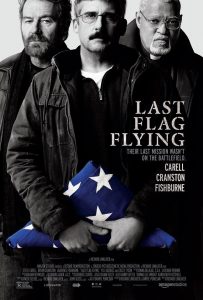
A truly moving cinematic experience that’s not to be missed. With a rollercoaster of emotions and an intriguing road trip narrative, the film takes viewers through an array of feelings and moods from tremendous hilarity to profound sadness, and nearly always seamlessly. Most of all, however, this latest offering from director Richard Linklater features three of the strongest male lead performances to come along in quite a while (kudos to the casting director for skillfully choosing Steve Carell, Bryan Cranston and Laurence Fishburne for their remarkable portrayals and their undeniable chemistry). Admittedly, the picture gets off track a few times, going on several needless tangents, but overall this strong, solid film is well worth one’s time. It’s truly unfortunate that this release has been noticeably, if not deliberately, ignored for awards consideration.
5. “Columbus”
A nearly perfect film in virtually every regard, this quiet, cerebral meditation about life, loving, healing, forgiveness, personal growth and human relations gives viewers much to think about, especially when faced with hard choices. Set against the beautiful backdrop of architectural mecca Columbus, Indiana, the film’s exquisite, Kubrick-esque cinematography, ethereal, haunting score, and deft use of sound provide elegant wrapping for this sometimes-humorous, sometimes-heartbreaking, frequently mesmerizing tale. Don’t expect much action from this one; in fact, don’t be surprised if you often find yourself wondering where the story is going, given its often-cryptic dialogue. But sit back, let the film wash over you and take it all in – you’ll likely be very pleasantly surprised, especially by the outstanding performance of John Cho, who demonstrates talents not seen in any of his previous roles. A quiet masterpiece.
4. “Brigsby Bear”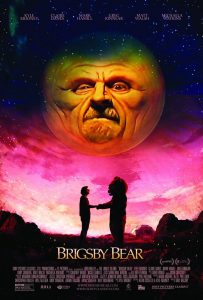
One of the most creative, thoughtfully written comedy-dramas in recent years. Its quirky but touching narrative, superb script and fine performances make this offbeat, description-defying release a captivating piece of filmmaking from start to finish. And, the closer you pay attention to this one, the more you’ll see, a truly gratifying moviegoing experience. Hooray for Brigsby!
3. “The Shape of Water”
Though at times a little formulaic, this inventive fantasy/fairy tale delivers the goods with superb special effects, gentle humor, heartwarming sincerity, and a host of excellent performances, especially by Sally Hawkins, Octavia Spencer and Richard Jenkins. Think “Beauty and the Beast” meets “E.T.,” and you’ve got a good idea what’s going on here. This one may strike a few odd chords, but it nearly always does so in perfect pitch.
2. “Three Billboards Outside Ebbing, Missouri”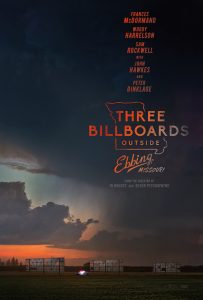
This dark comedy-drama, with its ample, in-your-face gallows humor and unrelenting colorful vulgarity, takes big chances on its way to easily becoming one of the best releases of 2017. With stellar performances by Frances McDormand, Woody Harrelson and Sam Rockwell, the picture keeps us guessing, even when we think we’ve figured things out, using assorted misdirections to captivate viewers throughout. Despite a slight tendency to drag in the second half, the film overall is a flat-out winner, though definitely not something for the sensitive or squeamish.
1. “I, Tonya”
Handily the year’s best, with its wickedly macabre humor and superb performances across the board, especially Margot Robbie and Allison Janney in positively stellar performances. With a kick-ass soundtrack, impeccable editing, excellent writing and a spot-on monologue format, this cynical, fact-based biopic carries the day in virtually every regard. To be sure, sensitive viewers may be offended by some of the language and violence, but both are properly balanced and in context. If you like your comedies with an edge, rush to see this one.
HONORABLE MENTIONS (IN NO PARTICULAR ORDER)
“The Big Sick”
A charming yet edgy romantic comedy that breathes new life into a genre that has grown progressively tiresome and stale. Based on the protagonist’s own unusual courtship experience, the film takes chances that movies of this ilk are seldom willing to do. Despite a slight tendency to drag a bit in the final 30 minutes, this fresh, lively offering features fine performances all around (especially by Holly Hunter and Ray Romano in strong supporting roles) and raucously funny bits not typical of rom-coms. See this one – you won’t regret it.
“Lucky”
Though sometimes a little too cryptic for its own good, this otherwise-reflective meditation on life, existence, mortality and human relations provides viewers with much to ponder about the state of one’s reality and how it’s shaped. With an excellent, career-topping performance by the late Harry Dean Stanton, coupled with a strong supporting ensemble, this quiet, low-key debut feature from actor-director John Carroll Lynch explores the meaning of life and the secrets to help make it fulfilling, both while we’re here and as we’re about to make our ultimate transition. A promising first effort from a filmmaking newcomer and the crowning achievement of a veteran performer’s repertoire.
“Battle of the Sexes”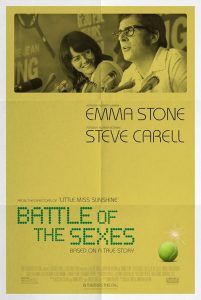
A well-crafted time capsule offering that superbly re-creates one of the biggest sports and social spectacles in recent history. With excellent performances by Emma Stone and Steve Carell – who practically channel the essence of their characters – and masterful period piece production values, this entertaining offering effectively captures the look and feel of its subject matter and its place in modern American cultural history. Admittedly, the picture tends to drag slightly in the first 45 minutes, but, this shortcoming aside, the film otherwise delivers in every other regard. Game, set, match.
“Marjorie Prime”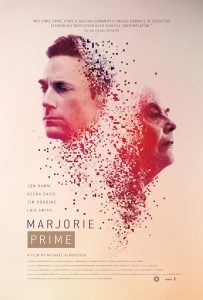
A thoughtful, insightful look at coping with grief, promoting healing, reconciling interpersonal discord, preserving memory, growing comfortable with technology, assessing the nature of reality and contemplating the fate of human evolution, all wrapped up in an intimate, beautifully filmed, well-acted, smartly conceived sci-fi offering. Although the script at times doesn’t quite rise up to the level of its narrative and Pulitzer Prize-nominated source material, the film nevertheless touches many bases and gives viewers much to contemplate. With an excellent ensemble cast, highlighted by a superb performance by long-underappreciated character actress Lois Smith, this latest production from director Michael Almereyda once again distinguishes the filmmaker as one of today’s most inventive, ambitious and underrated talents in the business. “Marjorie Prime” may be a little difficult to find, but it’s well worth the search.
“The Journey”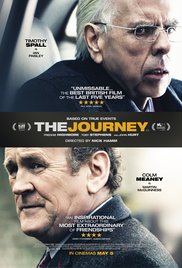
What it lacks in authenticity is more than made up for by its fictional though thoughtful debates of the issues at the heart of the Northern Ireland peace process, why it took so long to resolve and the remarkable steps it required to bring about a workable solution. Add to that the sizzling performances of Timothy Spall and Colm Meaney, and you’ve got a riveting series of dialogues that, in lesser hands, might easily have come off as a dry, plodding history lesson. While I usually have issues with films that take such blatant dramatic license, and even though the writing and narrative occasionally go wildly off the rails, this inventive take on this subject matter satisfies immensely without ever becoming tedious or pretentious. There’s much more here than what many of the dismissive accounts contend, and it involves material worth watching – and perhaps applying when circumstances merit.
“Beatriz at Dinner”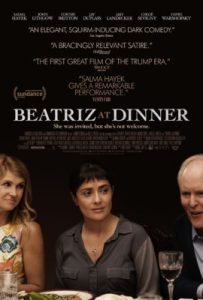
At times brilliant, at times frustrating, this dark, sociopolitical satire gives viewers much to ponder both practically and metaphysically, a rare fusion for a film these days. It also manages to maintain a fair amount of suspense at an event – a dinner party – that would seem an unlikely setting for such a narrative quality. Salma Hayek gives one of the year’s best performances, more than adequately backed by a superb ensemble of supporting players, most notably John Lithgow. Admittedly, it’s a little disappointing that the film draws upon a concluding plot device that’s been used before (even if it’s employed in a way not seen before), but, this disappointment aside, “Beatriz at Dinner” gives us much to think about at a critical juncture in our country’s – and our reality’s – history.
“The Post”
After a painfully slow start, “The Post” thankfully finds its legs about 40 minutes in, at last taking off on a more engaging pace as it moves toward an inspiring (albeit predictably feel good) conclusion. It’s a film with a timely (though, one can’t help but cynically wonder, regrettably tardy) message about the state of journalism in an America presently besieged by corporate media consolidation and heavy-handed attempts to quash free speech. Meryl Streep and Tom Hanks turn in adequate performances in their lead roles (though definitely far from their best), with the real stars shining in the supporting parts (particularly Bob Odenkirk, Bruce Greenwood and Matthew Rhys). Given the current political climate, “The Post” is the right film with the right message that liberal Hollywood adores and loves to lavish with honors. It’s just too bad that it’s not a better picture.
“Film Stars Don’t Die in Liverpool”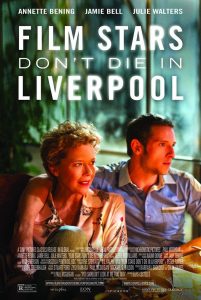
A vastly underrated gem that definitely deserves wider attention – and more recognition – than it has received thus far. With what is arguably Annette Bening’s best screen performance, coupled with a fine counterpart lead portrayal by Jamie Bell and an emotive closing song by Elvis Costello, this heartfelt romantic tearjerker justifiably earns every bit of emotion it evokes from audiences. Don’t listen to the cynics; if you enjoy good old-fashioned love stories, go see this one, but keep the tissues handy.
“The Hero”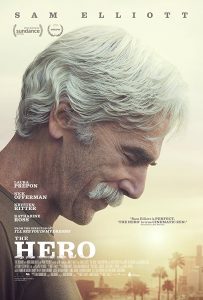
A quiet but powerful character study about an aging Western movie actor full of regrets seeking to make amends with whatever time he has left. Featuring a solid performance by Sam Elliott in a rare leading role, the film touches the heart without ever becoming maudlin, sappy or manipulative. A genuine surprise worthy of one’s time.
BOTTOM 10
10. “Paris Can Wait”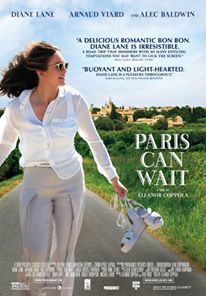
Though beautifully filmed, this journey through the French countryside can never really make up its mind if it wants to be a travelogue or a romantic escapade. Short on character development and interpersonal chemistry but long on lusciously photographed examples of French cuisine, the story meanders through a largely unconvincing narrative toward a predictable and unsatisfying ambiguous conclusion. This ground has been covered in a number of other prior offerings – and better. Clearly, this is one on which we can all wait.
9. “Wonder Wheel”
While stunning visually, this latest offering from filmmaker Woody Allen has to rank among the worst of his offerings. With leads who are horribly miscast (especially Kate Winslet in a bombastic exercise of overacting), writing that’s seriously bloated and in need of retooling, and characters who are neither likable nor believable, the film tells a tale that in many ways feels like a working class 1950s retread of “Blue Jasmine” with elements of “Café Society” thrown in. As much of a fan as I am of the director’s work, I whole-heartedly recommend skipping this one – and hope that he gets back on track with his next project.
8. “The Beguiled”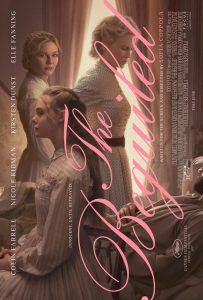
While atmospherically on target, this tedious slog never engages, leaving viewers waiting for an ending that takes far too long to come, even in spite of its scant 94-minute runtime. Half-baked performances that could have been phoned in, underscored by virtually nonexistent Southern accents, make for a cast of confederate belles who look bored, disinterested, even robotic at times. The sinister, macabre suspense depicted in the film’s preview makes the picture appear more captivating than it is, a genuine disappointment to be sure. Watch the trailer instead of the theatrical release for this one, and you’ll see a better, if shorter, movie.
7. “Alien: Covenant”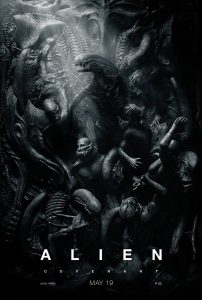
This is a franchise sorely in need of something radically fresh to keep it alive or a cancellation notice to put it (and viewers) out of misery. With the exception of a few spiritual vs. scientific plot devices, there’s essentially nothing new here that we haven’t already seen many (and I do mean many) times before. Any attempts at enlivening the narrative are derivative at best, shedding no particularly new light on why any of this matters (or why viewers should care). Go back and watch the first two movies in the series – they’re much better.
6. “Valerian and the City of a Thousand Planets”
Simply put, a big, fat, incredibly overlong snooze. This poorly written, frequently trite and shamelessly derivative alleged action-adventure saga sapped most of my interest about 20 minutes into its nearly 2.5-hour runtime. To make matters worse, this needlessly episodic trial of viewer patience features abysmal casting (save for a few supporting players irretrievably trapped in their thankless roles), special effects that seem to exist largely for their own sake and a woefully inadequate back story that cripples the picture almost from the outset. Avoid this one if you possibly can.
5. “Mother!”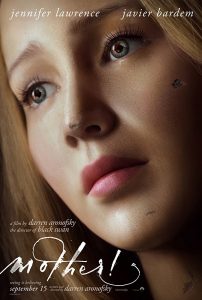
Pretentious! Obvious! Crap! There – I said it flat out, with the same kind of in-your-face, virtually nonstop barrage of gratuitous imagery that makes up much of the content of this over-the-top exercise in cinematic self-indulgence. Despite several fine performances (particularly Michelle Pfeiffer) and an inventive production design, these assets can’t save this morass of self-evident religious cliché mixed with contemporary social commentary. See this one at your peril lest you come away from it saying “There’s two hours of my life I'll never get back.”
4. “The Killing of a Sacred Deer”
When making a psychological thriller, the cardinal rule is not to make it boring, but, unfortunately, this dull, unintelligible offering falls into that trap within the first 10 minutes. A stilted script, wooden performances and undecipherable narrative drive this cinematic mess into the ground quickly. It’s truly disappointing that the creator of “The Lobster” followed up that brilliant work with this self-indulgent garbage. It’s one thing for a film to be off-beat and unconventional, but it’s something else entirely to be so muddled that it’s impossible to figure out what’s going on. Oh, and by the way, Colin Farrell and Nicole Kidman – given that you’ve each got two films in my Bottom 10, please start picking your scripts better.
3. “Life”
“Derivative,” it seems, is not just a financial term – it’s also an apt way of describing this flat, unoriginal, overlong, poorly written knock-off of “Alien” with homages to “Gravity” and “Armageddon” thrown in for good measure. The story is wholly predictable in virtually every regard, right down to its supposed final plot twist. Some of the special effects are genuinely well done, but some others are positively silly. It’s easy to see how this one got moved out of the summer blockbuster release season; it would have been easily embarrassed by its competition. The film’s tag line says “We were better off alone”; that really should read “We were better off staying home.”
2. “The Circle”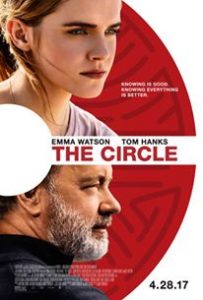
Is it a thriller? A satire? Both? Neither? It’s hard to tell, since the filmmakers obviously didn’t know what they were doing or trying to achieve. This overwrought, unfocused mess can’t decide what it wants to be. Despite a decent performance by Tom Hanks and an attempt to address issues of social relevance (halfhearted though that effort may be), the picture’s largely preposterous story line, monodimensional character development, and abysmal performances by Emma Watson and (especially) Ellar Coltrane sink this one rather quickly, leaving viewers longing for the ending far ahead of its arrival. Handily one of the biggest disappointments of the year.
1. “Split”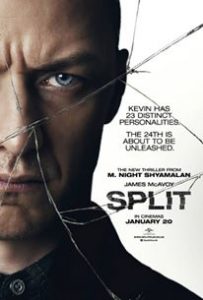
A positively awful movie and a sad cinematic commentary on the career of a director who was once one of Hollywood’s shiny rising stars. Despite James McAvoy’s admirable attempt at putting lipstick on this celluloid pig, as well as some allegedly lofty efforts at trying to elevate the tone of the narrative above its simplistic, unsettling nature, there’s nothing here to make this glorified slasher picture memorable, insightful or, at times, watchable. Keep those hard-earned dollars in your wallet.
DISHONORABLE MENTIONS (IN NO PARTICULAR ORDER)
“Wonderstruck”
When one watches a film with the word “Wonder” in the title, one expects it to evoke feelings in line with that term. However, this drawn-out, sleepy mess never lives up to its billing, leaving viewers constantly hankering for the story to “get on with it already.” A true waste of talent, cinematic resources and viewers’ time.
“The Wedding Plan”
What starts out as a modestly funny premise begins falling apart about midway through by lapsing into a series of prolonged, talky conversations that lack even moderate laughs and harp on belabored spiritual and philosophical musings. It’s unfortunate that the filmmakers didn’t tap into the deep veins of humorous potential here, instead choosing to serve up something far less substantial than it could have been. Send your regrets, and skip this one.
“Ghost in the Shell”
It’s unfortunate when the substance of a good story gets buried under layers of cinematic style, keeping the essence of the underlying narrative from shining through. But that’s precisely the problem with this live action anime feature. An over-reliance on action sequences and stunning (but decidedly excessive) visual effects dilutes the relevance and poignancy of this film, depriving viewers of the most important attribute it has to impart. Scarlett Johansson’s staid, detached bad-ass routine is growing a little stale, too, a virtual carbon copy of the performances she gave in “Lucy” and “Under the Skin.” And then there’s the movie’s tendency to borrow from numerous other sources, like “Blade Runner,” “The Matrix,” “Cloud Atlas,” “Ex Machina” and “Total Recall,” to name a few. Pass on this one – you won’t miss much.
“Call Me By Your Name”
Though beautifully filmed and scored, with generally capable performances, this overrated, tiresome, trite exercise in tedium disappoints overall. With a script characterized by bloated, stilted, implausible dialogue and a narrative that’s been done countless times before, there’s precious little about this annoying slog that we haven’t already seen many, many times previously. Save for one particularly touching scene toward the film’s close that helps to redeem much of what precedes it, “Call Me By Your Name” fails to live up to its potential – or its press releases.
“Phantom Thread”
Despite exquisite costume design, some occasionally humorous moments, and fine performances by Daniel Day-Lewis and Lesley Manville, this exercise in pretentious self-indulgence passing itself off as audacious art is cold, unengaging and implausible virtually from the outset. This bizarre fusion of “Fifty Shades of Grey,” “The Devil Wears Prada” and “The Beguiled” never gels and leaves viewers wholly unsatisfied by the end of its overlong runtime. It’s unfortunate that Day-Lewis chose this vehicle as the performance to cap off his otherwise-brilliant career.
Copyright © 2017-18, by Brent Marchant. All rights reserved.
